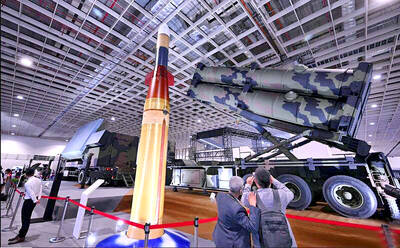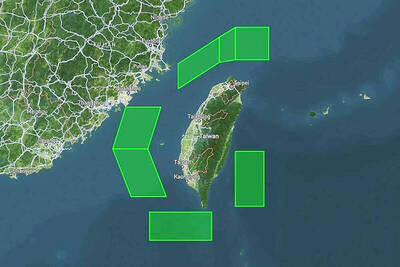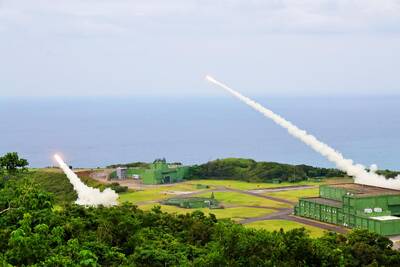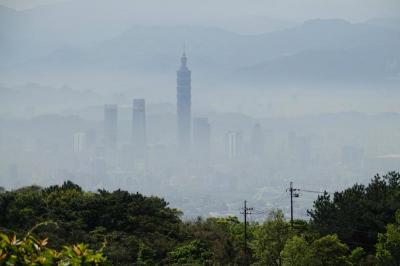Preceded by an impressive performance of traditional Sediq warrior dance, film director Wei Te-sheng (魏德聖) announced at a press conference yesterday that filming for a movie on a large-scale war of resistance led by a Sediq chieftain Mona Rudao was completed.
Feeling that they could not tolerate the repression and exploitation of the Japanese colonial government, more than 1,000 Sediq warriors from six villages around Wushe (霧社) in present day Renai Township (仁愛), Nantou County, launched a fierce resistance against the Japanese under the leadership of one of the chieftains, Mona Rudao.
Although they gained the upper hand in the beginning, the Sediq resistance was later defeated when the Japanese persuaded a rival Sediq sub-tribe to join their side and used poison gas against the Sediqs.
Mona Rudao, along with hundreds of other Sediq — including women and children — committed suicide after realizing they could not fight back, while about 500 surrendered.
However, about 300 of those who surrendered were later killed in a massacre, while the remaining survivors were forced to resettle to a new location.
“I never thought I could really finish this movie in the beginning, but we finally got it done,” Wei told the press conference. “The shooting of the movie was completed thanks to the hard work of all the crew members and actors, as well as those who provided all kinds of assistance — and I felt that it was also because we had some luck.”
The news conference took place at one of the movie sets of the movie Seediq Bale in Linkou Township (林口), Taipei County: a reconstructed scene of the main street in Wushe in the 1930s.
Lack of funding was the major problem for Wei and his team.
“At one point, I was unable to pay my crew members for three months, but I am really grateful that they trusted in me and continued to work,” Wei said.
Media have reported that more than NT$600 million (US$18 million) was spent in the making of the movie. Wei did not confirm the number at the press conference, saying he hoped the movie would sell well enough to cover the costs after it’s released next summer.
Aside from the 400-member crew from Taiwan, South Korea and Japan, as many as 15,000 actors took part in the making of the movie — many were not professional actors and members of the Sediq, Truku and Atayal tribes.
“I wanted to take part in the movie because I’ve always been proud to be a Truku,” Halong Ikuy, who played the role of both a Sediq warrior and a Japanese soldier, told the Taipei Times.
“Before, I always thought movies are only for entertainment, and acting is just bringing the story to life, but now I have a different understanding,” he said. “By acting in Seediq Bale, I began to feel how miserable Aborigines have been treated historically. It also made me start to wonder how we keep our own culture, tribe and everything when facing a more dominant culture from the outside — be it the Japanese, the Han or other Aboriginal tribes.”
Halong Ikuy’s younger sister, Sayun Ikuy, who played the role of Mona Rudao’s wife, said she now knows more about the history and it made her more proud to be an Aborigine.

Taiwan is to commence mass production of the Tien Kung (天弓, “Sky Bow”) III, IV and V missiles by the second quarter of this year if the legislature approves the government’s NT$1.25 trillion (US$39.78 billion) special defense budget, an official said yesterday. Commenting on condition of anonymity, a defense official with knowledge of the matter said that the advanced systems are expected to provide crucial capabilities against ballistic and cruise missiles for the proposed “T-Dome,” an advanced, multi-layered air defense network. The Tien Kung III is an air defense missile with a maximum interception altitude of 35km. The Tien Kung IV and V

The disruption of 941 flights in and out of Taiwan due to China’s large-scale military exercises was no accident, but rather the result of a “quasi-blockade” used to simulate creating the air and sea routes needed for an amphibious landing, a military expert said. The disruptions occurred on Tuesday and lasted about 10 hours as China conducted live-fire drills in the Taiwan Strait. The Civil Aviation Administration (CAA) said the exercises affected 857 international flights and 84 domestic flights, affecting more than 100,000 travelers. Su Tzu-yun (蘇紫雲), a research fellow at the government-sponsored Institute for National Defense and Security Research, said the air

Taiwan lacks effective and cost-efficient armaments to intercept rockets, making the planned “T-Dome” interception system necessary, two experts said on Tuesday. The concerns were raised after China’s military fired two waves of rockets during live-fire drills around Taiwan on Tuesday, part of two-day exercises code-named “Justice Mission 2025.” The first wave involved 17 rockets launched at 9am from Pingtan in China’s Fujian Province, according to Lieutenant General Hsieh Jih-sheng (謝日升) of the Office of the Deputy Chief of the General Staff for Intelligence at the Ministry of National Defense. Those rockets landed 70 nautical miles (129.6km) northeast of Keelung without flying over Taiwan,

A strong continental cold air mass is to bring pollutants to Taiwan from tomorrow, the Ministry of Environment said today, as it issued an “orange” air quality alert for most of the country. All of Taiwan except for Hualien and Taitung counties is to be under an “orange” air quality alert tomorrow, indicating air quality that is unhealthy for sensitive groups. In China, areas from Shandong to Shanghai have been enveloped in haze since Saturday, the ministry said in a news release. Yesterday, hourly concentrations of PM2.5 in these areas ranged from 65 to 160 micrograms per cubic meter (mg/m³), and pollutants were